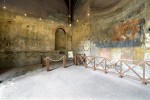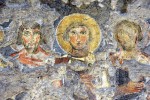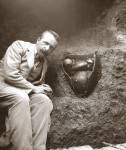 For the first time since it was discovered in 1900, a monumental ramp built by Emperor Domitian in Rome opened to the public on Tuesday, October 20th. Domitian built the ramp in the second half of the 1st century A.D. to connect the Roman Forum, the administrative and political heart of the city, to the imperial palace complex of the Palatine, the city’s center of power. With high walls flanked by storerooms, the imperial ramp went up seven levels with six turns between them and was as much as 35 meters (115 feet) high. Of the seven original ramps levels, four remain, but they are more than sufficient to convey the majesty of the space and the symbolic significance of the steep ascension from popular politics to imperial might. Visitors who walk the ramp will emerge atop the Palatine to a breathtaking view of the Roman Forum that before now regular folks haven’t had the chance to experience.
For the first time since it was discovered in 1900, a monumental ramp built by Emperor Domitian in Rome opened to the public on Tuesday, October 20th. Domitian built the ramp in the second half of the 1st century A.D. to connect the Roman Forum, the administrative and political heart of the city, to the imperial palace complex of the Palatine, the city’s center of power. With high walls flanked by storerooms, the imperial ramp went up seven levels with six turns between them and was as much as 35 meters (115 feet) high. Of the seven original ramps levels, four remain, but they are more than sufficient to convey the majesty of the space and the symbolic significance of the steep ascension from popular politics to imperial might. Visitors who walk the ramp will emerge atop the Palatine to a breathtaking view of the Roman Forum that before now regular folks haven’t had the chance to experience.
 Also restored is a great hall which in the early Middle Ages was converted into the Oratorio of the Forty Martyrs, dedicated to the Forty Martyrs of Sebaste. Built no later than the 8th century, the Oratorio is adjacent to the Byzantine church of Santa Maria Antiqua, famed for its rare frescoes, and signficant portions of the Oratorio’s original Byzantine frescoes have survived as well. They date to the 8th and 9th centuries and depict a procession of saints and
Also restored is a great hall which in the early Middle Ages was converted into the Oratorio of the Forty Martyrs, dedicated to the Forty Martyrs of Sebaste. Built no later than the 8th century, the Oratorio is adjacent to the Byzantine church of Santa Maria Antiqua, famed for its rare frescoes, and signficant portions of the Oratorio’s original Byzantine frescoes have survived as well. They date to the 8th and 9th centuries and depict a procession of saints and  possibly St. Anthony of Egypt. The floor is made of repurposed marble fragments in a random jigsaw arrangement. The Oratorio has been accessible to the public in a limited way before, but just on its own. The new restoration has reintegrated it into the ramp, making it the entrance to Domitian’s complex.
possibly St. Anthony of Egypt. The floor is made of repurposed marble fragments in a random jigsaw arrangement. The Oratorio has been accessible to the public in a limited way before, but just on its own. The new restoration has reintegrated it into the ramp, making it the entrance to Domitian’s complex.
 The ramp was discovered by architect, engineer and archaeologist Giacomo Boni. Boni was appointed director of excavations of the Roman Forum in 1898 and he dug until works were interrupted by World War I in 1916. The years between 1899 and 1905 were particularly intensive. Boni made major discoveries during this time, among them the Lapis Niger and Vulcanal, the Regia, the Aedes Vestae (shrine of Vesta), an archaic necropolis next to the temple of Antoninus and Faustina and the Byzantine church of Santa Maria Antiqua.
The ramp was discovered by architect, engineer and archaeologist Giacomo Boni. Boni was appointed director of excavations of the Roman Forum in 1898 and he dug until works were interrupted by World War I in 1916. The years between 1899 and 1905 were particularly intensive. Boni made major discoveries during this time, among them the Lapis Niger and Vulcanal, the Regia, the Aedes Vestae (shrine of Vesta), an archaic necropolis next to the temple of Antoninus and Faustina and the Byzantine church of Santa Maria Antiqua.
 When he unearthed the imperial ramp of Domitian, he set about restoring it almost as soon as he found it, rebuilding the fallen brickwork of the vast vaulted ceilings of the first two levels and clearing the path all the way through to its connecting point with the Clivus Victoriae, a sloping road that went uphill from the Velabro, a former swamp between the Tiber and the Forum, to the top of the Palatine. The section of the ramp linking to the Clivus is still undergoing work, but is scheduled to open to visitors in March.
When he unearthed the imperial ramp of Domitian, he set about restoring it almost as soon as he found it, rebuilding the fallen brickwork of the vast vaulted ceilings of the first two levels and clearing the path all the way through to its connecting point with the Clivus Victoriae, a sloping road that went uphill from the Velabro, a former swamp between the Tiber and the Forum, to the top of the Palatine. The section of the ramp linking to the Clivus is still undergoing work, but is scheduled to open to visitors in March.
 A temporary exhibition (it ends January 10th, 2016) inside the ramp puts on display a selection of the most important ancient artifacts discovered during the excavation of the Forum. Also on display will be surviving 17th century wall frescos Boni stripped from the church of Santa Maria Liberatrice before demolishing it to expose the more ancient and glamorous Santa Maria Antiqua which had been part of Domitian’s imperial palace complex before being converted to a Christian church in the 6th century. The hall that would be transformed into the Oratorio of the Forty Martyrs, in fact, was just underneath Santa Maria Liberatrice.
A temporary exhibition (it ends January 10th, 2016) inside the ramp puts on display a selection of the most important ancient artifacts discovered during the excavation of the Forum. Also on display will be surviving 17th century wall frescos Boni stripped from the church of Santa Maria Liberatrice before demolishing it to expose the more ancient and glamorous Santa Maria Antiqua which had been part of Domitian’s imperial palace complex before being converted to a Christian church in the 6th century. The hall that would be transformed into the Oratorio of the Forty Martyrs, in fact, was just underneath Santa Maria Liberatrice.
This short clip from the Archaeological Superintendency of Rome has a few images of the 1900 excavation and the ramp as it is today.
[youtube=https://youtu.be/D5dQjpfNjmE&w=430]
I take it that the Romans used iron horse-shoes? Cantering along those tunnels must have made a hell of a clatter.
To say nothing of the iron nails used on the soles of caligae.